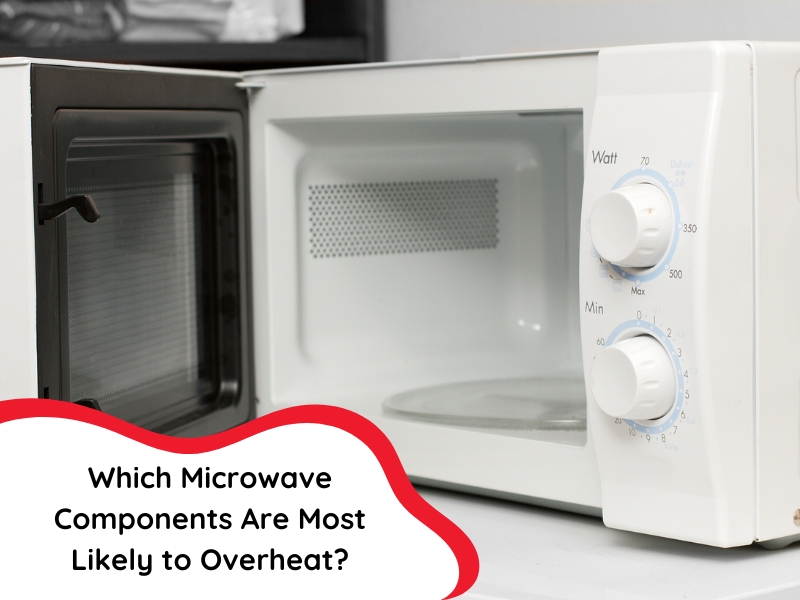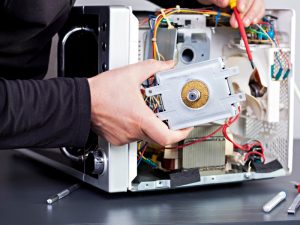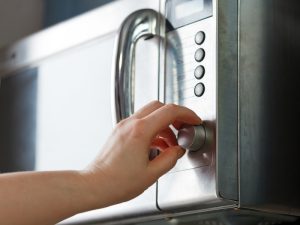Microwaves are essential appliances in most kitchens, making meal preparation quicker and more convenient. However, like any other appliance, they can experience problems.. One common problem that many people face is overheating. Overheating can affect a microwave’s performance and even cause lasting damage if not addressed. This article explores which components of a microwave are most likely to overheat and how to prevent such issues from affecting your appliance.
What are the common signs that your microwave is overheating?
Before diving into which parts of the microwave are more prone to overheating, it’s essential to recognise the warning signs that your microwave is indeed overheating. Identifying these early can help prevent more serious issues later on.
Common signs that your microwave may be overheating include:
- Unusual smells: If you smell burning plastic or an intense heat odour, it may indicate overheating inside the microwave.
- Hot exterior: If the microwave’s exterior is unusually warm to the touch, it could be a sign that internal components are getting too hot.
- Sudden shutdowns: If your microwave shuts off on its own, especially after running for an extended period, it might be overheating as a safety measure.
- Erratic performance: If your microwave isn’t cooking food evenly or is taking much longer than usual to heat, it may be due to overheating components.
How can overheating affect the microwave’s performance?
When a microwave overheats, it can cause a variety of performance issues. Here’s how it can affect the appliance:
- Decreased cooking efficiency: When a microwave overheats, it may fail to cook food evenly, leaving it undercooked or inconsistently heated, which can increase the risk of foodborne disease.
- Shortened lifespan: Continuous overheating can damage the internal components, causing wear and tear. This can lead to the appliance malfunctioning or breaking down completely.
- Increased power consumption: As the microwave struggles to operate under excessive heat, it may draw more power, leading to higher energy bills.
Which microwave components are prone to overheating?
There are several key components inside a microwave that are more likely to overheat due to their role in the cooking process. These include:
- Magnetron: This is the part of the microwave that generates the microwaves, and it can become damaged or overheated if the appliance is used too frequently or improperly. A malfunctioning magnetron is a common cause of overheating.
- Cooling fan: The cooling fan circulates air to help regulate the microwave’s temperature. If the fan fails or becomes obstructed, it can lead to overheating in the internal components.
- Power supply: The power supply converts electrical energy to power the microwave. If the power supply is faulty or overloaded, it may overheat, causing the microwave to malfunction.
- Transformer: The transformer helps regulate the voltage in the microwave. Overheating in the transformer can cause electrical issues that affect the microwave’s ability to heat food.
How can a faulty magnetron lead to overheating?
The magnetron is arguably the most critical component in a microwave. It generates the microwaves that cook your food, and if it starts to malfunction, it can quickly overheat. Here’s how:
- Worn-out internal components: Over time, the magnetron’s internal parts can wear down, causing it to operate inefficiently and generate excess heat.
- Excessive usage: Constant use without allowing the microwave to cool down can cause the magnetron to overheat, leading to damage and reduced performance.
- Incorrect installation: If the magnetron was not correctly installed or was installed incorrectly during maintenance, it may overheat during operation.
Overheating and ineffective food heating are both potential consequences of a faulty magnetron.
Can poor ventilation lead to microwave components overheating?
Yes, poor ventilation is another major cause of overheating in microwaves. The microwave requires adequate airflow to ensure that its components don’t get too hot. Without proper ventilation, the heat generated during operation cannot dissipate, and it begins to accumulate inside the appliance.
Here’s how poor ventilation affects the microwave:
- Blockage of vents: If the vents on the microwave are obstructed by dust, debris, or any other objects, the heat may not be able to escape, causing the components to overheat.
- Restricted airflow: installing a microwave in a poorly ventilated area. Poor airflow can trap heat, resulting in overheating and even damage to the internal components.
What should you do if your microwave components are overheating?
If you’ve noticed any signs of overheating, it’s essential to take action immediately to prevent further damage. Here are a few steps you can take:
- Turn off the microwave: If you suspect your microwave is overheating, turn it off immediately to prevent further damage.
- Check the vents: Ensure the vents are not blocked by dust or debris. If they are, clean them to allow for better airflow.
- Let it cool down: Give the microwave some time to cool down before using it again. Overusing an overheated microwave can lead to more significant damage.
- Call a technician: If the problem persists or you can’t identify the cause of the overheating, it’s best to call a professional technician to inspect and repair the microwave.
Can repairing a microwave fix overheating problems, or is buying a refurbished one a better choice?
When faced with overheating issues, many consumers may wonder whether it’s worth repairing the microwave or simply replacing it. Both options have their advantages, depending on the situation:
- Repairing: If the issue is isolated to one component, such as a faulty cooling fan or a worn-out magnetron, repairing the microwave may solve the overheating problem. A professional technician can often fix these issues.
- Buying a refurbished microwave: If the microwave is older or has experienced multiple overheating issues, purchasing a refurbished microwave might be a more suitable option. Refurbished microwaves are thoroughly tested, cleaned, and repaired before being sold, so they offer a more reliable and cost-effective solution.
If you’re dealing with frequent overheating issues, buying a refurbished microwave from a trusted supplier can save you time, money, and frustration.
Keep your microwave running smoothly
Microwave overheating is a common issue, but with proper maintenance and prompt attention, it’s possible to keep your appliance running smoothly. Regularly clean the vents, keep an eye on the components, and seek professional help if needed.
If you’re facing persistent overheating issues, buying a refurbished microwave may be a more cost-effective solution. Microwave Factory offers refurbished and factory-second microwaves at discounted prices, making it an excellent option for budget-conscious consumers. Whether you’re looking to replace a faulty microwave or upgrade to a more efficient model, investing in a quality refurbished appliance is a wise choice. Contact Microwave Factory today.



